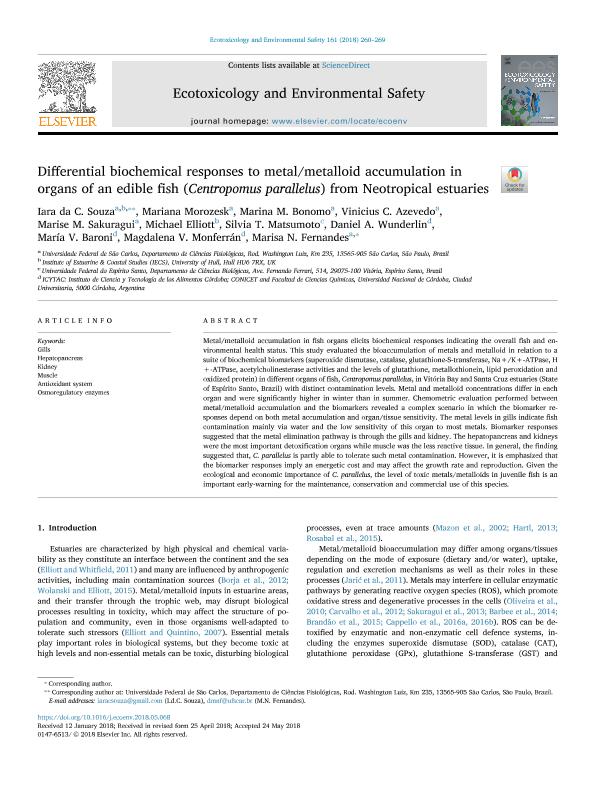Artículo
Differential biochemical responses to metal/metalloid accumulation in organs of an edible fish (Centropomus parallelus) from Neotropical estuaries
Souza, Iara da C.; Morozesk, Mariana; Bonomo, Marina M.; Azevedo, Vinicius C.; Sakuragui, Marise M.; Elliott, Michael; Matsumoto, Silvia T.; Wunderlin, Daniel Alberto ; Baroni, María Verónica
; Baroni, María Verónica ; Monferran, Magdalena Victoria
; Monferran, Magdalena Victoria ; Fernandes, Marisa N.
; Fernandes, Marisa N.
 ; Baroni, María Verónica
; Baroni, María Verónica ; Monferran, Magdalena Victoria
; Monferran, Magdalena Victoria ; Fernandes, Marisa N.
; Fernandes, Marisa N.
Fecha de publicación:
10/2018
Editorial:
Academic Press Inc Elsevier Science
Revista:
Ecotoxicology and Environmental Safety
ISSN:
0147-6513
Idioma:
Inglés
Tipo de recurso:
Artículo publicado
Clasificación temática:
Resumen
Metal/metalloid accumulation in fish organs elicits biochemical responses indicating the overall fish and environmental health status. This study evaluated the bioaccumulation of metals and metalloid in relation to a suite of biochemical biomarkers (superoxide dismutase, catalase, glutathione-S-transferase, Na+/K+-ATPase, H+-ATPase, acetylcholinesterase activities and the levels of glutathione, metallothionein, lipid peroxidation and oxidized protein) in different organs of fish, Centropomus parallelus, in Vitória Bay and Santa Cruz estuaries (State of Espírito Santo, Brazil) with distinct contamination levels. Metal and metalloid concentrations differ in each organ and were significantly higher in winter than in summer. Chemometric evaluation performed between metal/metalloid accumulation and the biomarkers revealed a complex scenario in which the biomarker responses depend on both metal accumulation and organ/tissue sensitivity. The metal levels in gills indicate fish contamination mainly via water and the low sensitivity of this organ to most metals. Biomarker responses suggested that the metal elimination pathway is through the gills and kidney. The hepatopancreas and kidneys were the most important detoxification organs while muscle was the less reactive tissue. In general, the finding suggested that, C. parallelus is partly able to tolerate such metal contamination. However, it is emphasized that the biomarker responses imply an energetic cost and may affect the growth rate and reproduction. Given the ecological and economic importance of C. parallelus, the level of toxic metals/metalloids in juvenile fish is an important early-warning for the maintenance, conservation and commercial use of this species.
Palabras clave:
ANTIOXIDANT SYSTEM
,
GILLS
,
HEPATOPANCREAS
,
KIDNEY
,
MUSCLE
,
OSMOREGULATORY ENZYMES
Archivos asociados
Licencia
Identificadores
Colecciones
Articulos(CIBICI)
Articulos de CENTRO DE INV.EN BIOQUI.CLINICA E INMUNOLOGIA
Articulos de CENTRO DE INV.EN BIOQUI.CLINICA E INMUNOLOGIA
Articulos(ICYTAC)
Articulos de INST. DE CIENCIA Y TECNOLOGIA DE ALIMENTOS CORDOBA
Articulos de INST. DE CIENCIA Y TECNOLOGIA DE ALIMENTOS CORDOBA
Citación
Souza, Iara da C.; Morozesk, Mariana; Bonomo, Marina M.; Azevedo, Vinicius C.; Sakuragui, Marise M.; et al.; Differential biochemical responses to metal/metalloid accumulation in organs of an edible fish (Centropomus parallelus) from Neotropical estuaries; Academic Press Inc Elsevier Science; Ecotoxicology and Environmental Safety; 161; 10-2018; 260-269
Compartir
Altmétricas



